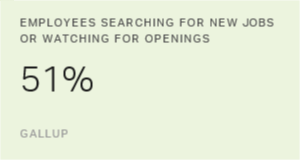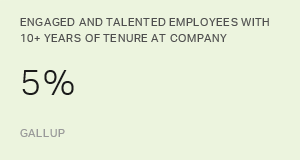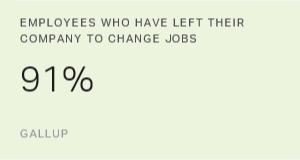Story Highlights
- Many employees feel confident and are looking for new jobs
- Employees are leaving their jobs for numerous reasons
- The more disconnected employees feel, the greater their readiness to job hop
This is the second article in a two-part series.
As the first article in this series noted, while some workers still find the U.S. job market bleak, others are confident and ready to look for new jobs. And the latter group -- which probably includes your star employees -- could be ready to leave your company. They might already be slipping away.
Changes in the U.S. job market have major implications for organizations, according to Gallup's State of the American Workplace report. The more that employees believe the job market is opening up, the less likely they may be to stay in roles that don't meet their needs and expectations.
And many are already looking for new opportunities. Slightly more than half of employees (51%) say they are actively looking for a new job or watching for openings, and 35% of workers report changing jobs within the past three years.
This shouldn't come as a surprise, as 33% of employees are engaged in their jobs. Lack of engagement gives many workers the incentive to explore their options.
Employees also have a "grass is greener" mentality. An overwhelming majority of employees (91%) say that the last time they switched jobs, they left their employer to do so.
This is unfortunate, as Gallup analysis shows that the longer people stay at their jobs, the more likely they are to strongly agree they have opportunities to do what they do best every day (a key element of engagement). Organizations could be losing many workers -- including their best ones -- before these people have the chance to realize their full potential.
Why Employees Leave Their Jobs
Employees are leaving their jobs for numerous reasons. The most common explanations employees give when voluntarily exiting their jobs are:
- career growth opportunities
- pay and benefits
- manager or management
- company culture
- job fit
Each of these explanations can link to some aspect of an organization's strategy for engaging employees. Workers who believe they're a poor fit for their jobs are unlikely to agree that they have opportunities to do what they do best every day. Similarly, workers who feel detached from their company cultures are unlikely to agree that the mission or purpose of their company makes them feel their job is important (another key element of engagement).
Pay and benefits also have an engagement connection. Gallup research has found that employees who do not agree their coworkers are committed to quality work (another key element of engagement) can develop feelings of resentment. These employees believe they are carrying more of the workload or producing better outcomes than their team members are and that they should be paid more as a result.
The more disconnected employees feel, the greater their readiness to job hop becomes. While 37% of engaged employees are looking for jobs or watching for opportunities, higher numbers of employees who are not engaged or actively disengaged are doing the same (56% and 73%, respectively).
Workers want to feel connected to their jobs, managers and companies. If those ties are not there, they have more incentive to quit, leaving their organizations to start the costly recruitment, hiring and onboarding dance all over again. This could also cost companies some of their best people.
Improving engagement has to start with organizations closely examining how they attract, retain and engage employees. They must give employees a reason to choose them, stay with them and perform at their best.
This article is part of Gallup's State of the Workplace Initiative. To learn more, we invite you to:
- download the most recent State of the American Workplace report
- watch our recent webinar, "Benefits and Perks: Perceptions vs. Reality"



